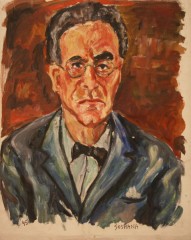May 13, 2019.Monteverdi, Satie, Klemperer.One of the most important composers in the history of European music, Claudio Monteverdi was born on May 15th of 1567 in Cremona.Rarely can we associate historically significant musical or esthetic developments with just one person, but Monteverdi is one of them: early in his life he wrote wonderful madrigals in the style of late Renaissance, and then transitioned to what we now call Baroque.In the process, he practically invented a new art form, the opera.You can read about him here, here and here.As a musical excerpt, we have his Lament ofArianna.We know it as a madrigal from Book Six, published in Venice in 1614, but originally it was composed or his early opera Arianna, now lost.Here it is performed by the Concerto Italiano under the direction of Rinaldo Alessandrini.
In some sense, Erik Satie, born on May 17th of 1866 in Honfleur to a French father and Scottish mother, was the opposite of Monteverdi: his musical output was slim (he’s mostly remembered for his Gymnopédies and Gnossiennes), his influence coming as much from his personality as his music.Satie was an eccentric (he ate only white-colored food, carried a hammer for protection and was involved in the occult).Still, he knew and was known to “everybody” of significance in the pre-WWI Paris.He had a long affair with Suzanne Valadon, a painter and mother of Morice Utrillo, was good friends with Ravel and Debussy and influenced Les Six.Later he got involved with the Dadaists and Surrealists. And, of course, he paved the way for the Minimalists. Here are three Gymnopédies, each about three and a half minutes long, performed by Jean-Yves Thibaudet, the Frenchman who recorded all piano works by Satie.
Otto Klemperer, one of the greatest conductors of his generation, was born on May 14th of 1885 in Breslau, Germany (now Wrocław, Poland).In 1905 he met Mahler, who helped Klemperer to get the conducting position at Neues Deutsches Theater in Prague, which launched Klemperer’s conducting career.He went on to conduct at several important opera houses; in 1927 he was appointed the music director of the Kroll Opera, a branch of the Berlin Staatsoper, created to promote contemporary music.There he conducted new operas by Stravinsky, Schoenberg, Hindemith and Janáček.Some of the Kroll Opera’s Wagner productions were so innovative that they affected the Bayreuth enactments half a century later.During that time, Klemperer also conducted the Kroll Concerts, where he performed significant contemporary pieces.In 1931 the Kroll Opera closed for lack of financing, but Klemperer remained at the Staatsoper.In 1933 the Nazis took over and Klemperer, who was Jewish, emigrated to the US.His first appointment was with the Los Angeles Philharmonic; his tenure there brought critical acclaim, but he wasn’t comfortable in Southern California, he preferred the East coast.He played several concerts with the New York Philharmonic, but when, in 1936, the position of Music Director opened with the departure of Arturo Toscanini, the orchestra board engaged John Barbirolli and, later, Artur Rodziński.Klemperer was hugely disappointed; he remained with the LA Phil till 1939 when a tumor was found in his brain.It was successfully removed but left Klemperer unable to conduct for several years.After the war he made several recordings with the newly created Philharmonia Orchestra in London and in 1959 was appointed its “Director for life.”He had a wonderful relationship with the musicians and made several remarkable recordings of Beethoven and Mahler’s symphonies.Klemperer died in Zurich on July 6th of 1973.Here’s the first movement of Beethoven’s Sixth Symphony, recorded in 1957.Otto Klemperer conducts the Philharmonia Orchestra.
Monteverdi, Satie, Klemperer 2019
May 13, 2019. Monteverdi, Satie, Klemperer. One of the most important composers in the history of European music, Claudio Monteverdi was born on May 15th of 1567 in Cremona. Rarely can we associate historically significant musical or esthetic developments with just one person, but Monteverdi is one of them: early in his life he wrote wonderful madrigals in the style of late Renaissance, and then transitioned to what we now call Baroque. In the process, he practically invented a new art form, the opera. You can read about him here, here and here. As a musical excerpt, we have his Lament of Arianna. We know it as a madrigal from Book Six, published in Venice in 1614, but originally it was composed or his early opera Arianna, now lost. Here it is performed by the Concerto Italiano under the direction of Rinaldo Alessandrini.
Rarely can we associate historically significant musical or esthetic developments with just one person, but Monteverdi is one of them: early in his life he wrote wonderful madrigals in the style of late Renaissance, and then transitioned to what we now call Baroque. In the process, he practically invented a new art form, the opera. You can read about him here, here and here. As a musical excerpt, we have his Lament of Arianna. We know it as a madrigal from Book Six, published in Venice in 1614, but originally it was composed or his early opera Arianna, now lost. Here it is performed by the Concerto Italiano under the direction of Rinaldo Alessandrini.
In some sense, Erik Satie, born on May 17th of 1866 in Honfleur to a French father and Scottish mother, was the opposite of Monteverdi: his musical output was slim (he’s mostly remembered for his Gymnopédies and Gnossiennes), his influence coming as much from his personality as his music. Satie was an eccentric (he ate only white-colored food, carried a hammer for protection and was involved in the occult). Still, he knew and was known to “everybody” of significance in the pre-WWI Paris. He had a long affair with Suzanne Valadon, a painter and mother of Morice Utrillo, was good friends with Ravel and Debussy and influenced Les Six. Later he got involved with the Dadaists and Surrealists. And, of course, he paved the way for the Minimalists. Here are three Gymnopédies, each about three and a half minutes long, performed by Jean-Yves Thibaudet, the Frenchman who recorded all piano works by Satie.
Otto Klemperer, one of the greatest conductors of his generation, was born on May 14th of 1885 in Breslau, Germany (now Wrocław, Poland). In 1905 he met Mahler, who helped Klemperer to get the conducting position at Neues Deutsches Theater in Prague, which launched Klemperer’s conducting career. He went on to conduct at several important opera houses; in 1927 he was appointed the music director of the Kroll Opera, a branch of the Berlin Staatsoper, created to promote contemporary music. There he conducted new operas by Stravinsky, Schoenberg, Hindemith and Janáček. Some of the Kroll Opera’s Wagner productions were so innovative that they affected the Bayreuth enactments half a century later. During that time, Klemperer also conducted the Kroll Concerts, where he performed significant contemporary pieces. In 1931 the Kroll Opera closed for lack of financing, but Klemperer remained at the Staatsoper. In 1933 the Nazis took over and Klemperer, who was Jewish, emigrated to the US. His first appointment was with the Los Angeles Philharmonic; his tenure there brought critical acclaim, but he wasn’t comfortable in Southern California, he preferred the East coast. He played several concerts with the New York Philharmonic, but when, in 1936, the position of Music Director opened with the departure of Arturo Toscanini, the orchestra board engaged John Barbirolli and, later, Artur Rodziński. Klemperer was hugely disappointed; he remained with the LA Phil till 1939 when a tumor was found in his brain. It was successfully removed but left Klemperer unable to conduct for several years. After the war he made several recordings with the newly created Philharmonia Orchestra in London and in 1959 was appointed its “Director for life.” He had a wonderful relationship with the musicians and made several remarkable recordings of Beethoven and Mahler’s symphonies. Klemperer died in Zurich on July 6th of 1973. Here’s the first movement of Beethoven’s Sixth Symphony, recorded in 1957. Otto Klemperer conducts the Philharmonia Orchestra.
1885 in Breslau, Germany (now Wrocław, Poland). In 1905 he met Mahler, who helped Klemperer to get the conducting position at Neues Deutsches Theater in Prague, which launched Klemperer’s conducting career. He went on to conduct at several important opera houses; in 1927 he was appointed the music director of the Kroll Opera, a branch of the Berlin Staatsoper, created to promote contemporary music. There he conducted new operas by Stravinsky, Schoenberg, Hindemith and Janáček. Some of the Kroll Opera’s Wagner productions were so innovative that they affected the Bayreuth enactments half a century later. During that time, Klemperer also conducted the Kroll Concerts, where he performed significant contemporary pieces. In 1931 the Kroll Opera closed for lack of financing, but Klemperer remained at the Staatsoper. In 1933 the Nazis took over and Klemperer, who was Jewish, emigrated to the US. His first appointment was with the Los Angeles Philharmonic; his tenure there brought critical acclaim, but he wasn’t comfortable in Southern California, he preferred the East coast. He played several concerts with the New York Philharmonic, but when, in 1936, the position of Music Director opened with the departure of Arturo Toscanini, the orchestra board engaged John Barbirolli and, later, Artur Rodziński. Klemperer was hugely disappointed; he remained with the LA Phil till 1939 when a tumor was found in his brain. It was successfully removed but left Klemperer unable to conduct for several years. After the war he made several recordings with the newly created Philharmonia Orchestra in London and in 1959 was appointed its “Director for life.” He had a wonderful relationship with the musicians and made several remarkable recordings of Beethoven and Mahler’s symphonies. Klemperer died in Zurich on July 6th of 1973. Here’s the first movement of Beethoven’s Sixth Symphony, recorded in 1957. Otto Klemperer conducts the Philharmonia Orchestra.